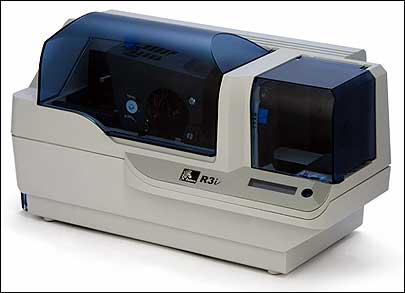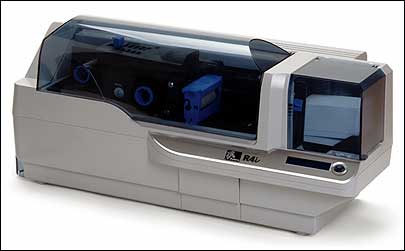Zebra Technologies has unveiled two devices that will enable companies to print and encode their own passive ultrahigh-frequency (UHF) RFID-enabled plastic cards, useable for a range of applications, from personal identification to asset tracking. Prior to the availability of these printer-encoders, end users have had to farm out the printing of such cards to RFID tag makers or custom print houses able to both embed an RFID inlay in a card and print the card faces.
Until recently, companies deploying a passive RFID application have had few choices when it came to RFID tag form factor. Standard RFID printer-encoders—those that encode Electronic Product Codes (EPCs) to RFID inlays embedded in standard shipping labels—designed for supply chain applications were the only off-the-shelf option. That began to change in 2006, however, when ADASA introduced a mobile encoder for simple, on-pitch inlays rather than full labels (see ADASA Developing Wearable Tag Encoder). In March 2007, printer manufacturer Lexmark introduced a laser printer (the T640rn) that can print 8.5-by-11-inch paper and encode RFID inlays embedded in the stock (see New Office Laser Printer Encodes Tags), opening new printing options to end users of passive RFID.
Zebra has built its two UHF RFID card printer-encoders using its existing Zebra card printer bodies, the P330i and the P430i. The R3i can print one side of RFID-enabled card stock, while the R4i can print on both sides. Both models include a ThingMagic Mercury 4e RFID encoder module, which is roughly the size of a credit card, supports two antennas and is designed to read and encode passive UHF tags complying with a variety of standards, including EPC Gen 2 and older protocols, such as ISO 18000-6B, EPC Class 0, rewriteable EPC Class 0 and EPC Class 1. However, says Bill Bulzoni, Zebra’s director of business development for RFID, all initial users of the card printers are exclusively employing EPC Gen 2 inlays. Going forward, he adds, he does not expect that customers will want to use older standards, such as EPC Class 0 or Class 1 Gen 1.
A number of Zebra customers are already utilizing the new RFID card printers, Bulzoni says, as part of building access-control systems. For this application, the card face is printed with an image of the person to whom the card is issued, along with an ID number that is also encoded to the card’s embedded RFID inlay. Unlike access-control cards containing low-frequency (LF) or high-frequency (HF) RFID tags, which have a short read range, a UHF-based access control card affords building security operators more visibility into who enters a facility. “If you have a low-frequency card and use it to open a locked door,” he says, “you may then hold the door open for a person behind you to enter, as well.” In such a scenario, the second person’s identity would not be captured, even though that individual might not have permission to enter the building.
The readers mounted near a doorway are likely to read a UHF card 10 or more feet away, however, so even if a person entering a building fails to present the card to an interrogator, the security system will likely collect that entrant’s identity passively. To authenticate each individual’s identity, surveillance cameras can be used to compare each entrant’s card data with his or her face, using facial recognition software. RFID systems integrator EPCsolutions utilizes the Zebra card printers in its TetraGate solution, both in combination with biometric scanning for authentication (TetraGate2) and without the addition of biometric scanning (TetraGateLite).
EPCsolutions’ CEO, Kevin Kail, says his firm is also incorporating the Zebra card printers in asset-tracking and work-in-process (WIP) applications it offers its customers. A few of those customers, he notes, are embarking on pilot deployments of such applications. An important benefit of using the UHF passive cards to track totes or other items in an asset-tracking or WIP application, Kail indicates, is that an end user can interrogate both the tote tag and EPC Gen 2 passive tags applied to products or parts inside the tote using a single reader infrastructure. When employing an active tag to track a tote, a separate interrogator would be required to read that tag.
Zebra does not produce RFID card printers for LF or HF tags, Bulzoni says, because there is already a large amount of competition in that arena. There is no such competition in the UHF card printer arena, however, and he says Zebra believes it has a large, ready market for the printers in the access-control and asset-tracking applications. What’s more, Bulzoni adds, retailers could use the printers to create RFID customer loyalty cards.
In tests, notes Bulzoni, passive UHF RFID cards encoded by the two printers offer a read range averaging 10 to 12 feet. If customers were to use the cards to identify assets with metal or liquid contents, however, the read range would most likely be less. To boost the read range in such scenarios, they would need to apply a buffering material or find another manner of offsetting the tags from the RF-interfering objects, such as by hanging the tag off the asset on a lanyard. The cards do not come with predrilled mounting or lanyard holes, so end users would need to make such modifications themselves, but they can order adhesive-backed cards.
The R3i model can print, encode and verify up to 144 cards per hour, while the R4i can print, encode and verify up to 130 single-sided cards or 102 double-sided cards per hour. The lower capacity for one-sided cards on the R4i, relative to the R3i, is due to the longer card feed in the R4i, Bulzoni explains. Both printers reject cards with faulty inlays and print in full color, at a resolution of 300 dots per inch.
The R3i and R4i are available now in North America, with prices beginning at $4,390 and $5,390, respectively, for models with USB connectivity. Versions containing Ethernet ports cost extra. Both machines can print on cards compliant with ISO standards CR-80-ISO 7810, ISO 7811 (which include a magnetic stripe on the card that the machines can also encode) and ISO 7816-2. According to Bulzoni, Zebra contracts with a third party to manufacture RFID plastic (polyvinyl chloride) cards made with an inlay developed by Zebra, using a dual-dipole antenna design and the latest Impinj Monza EPC Gen 2 chip. Bulzoni says end users can expect to pay $4 to $5 per standard Gen 2 UHF card.



